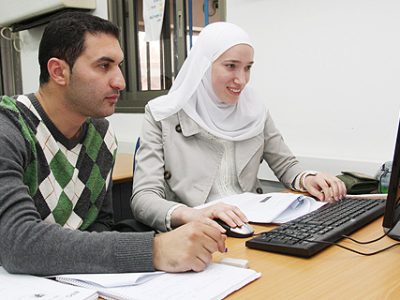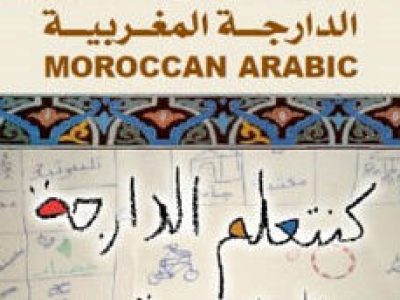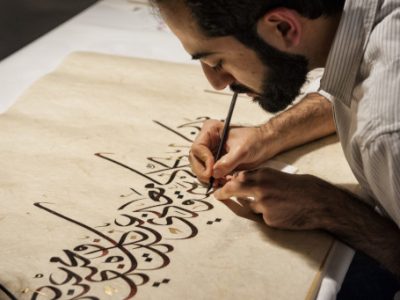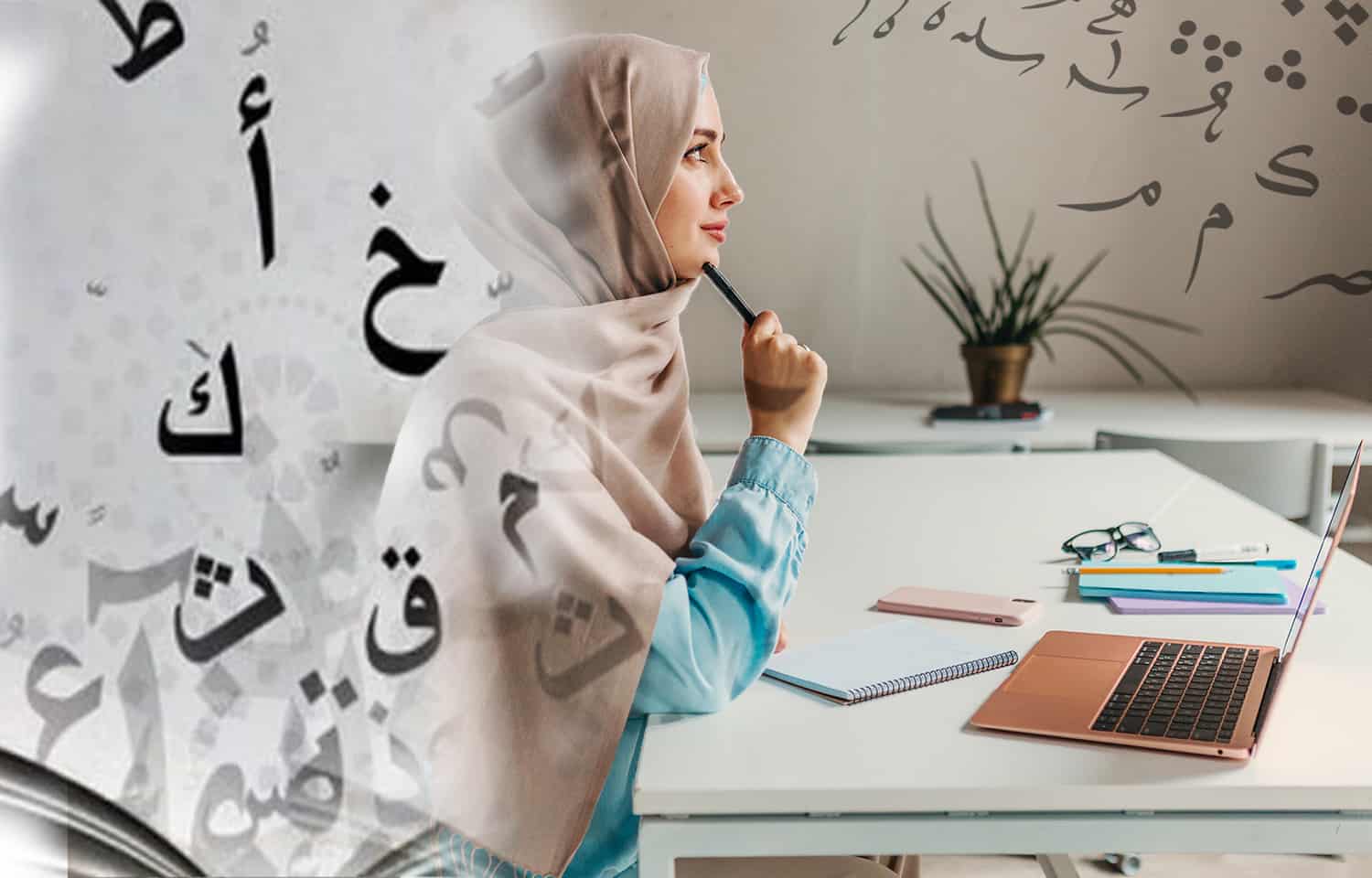Modern Standard Arabic is the lingua franca of the Arab speaking world, from Morocco to Malaysia. This is the language of Arab politics, business, media and literature. Conceived from Classical Arabic as well as various dialects, Modern Standard Arabic is the key to a career in and an understanding of the Arab world. With our intensive approach and fluently dedicated teachers, every student walks away from each class with a deeper comprehension – this is not an option at MCAS it is a must!
Course Descriptions and Objectvies :
Entery Level:
This level provides an introduction to Modern Standard Arabic (MSA). Students learn to read and write the complete Arabic alphabet and construct basic sentences. Students will acquire some basic vocabulary, develop oral-aural skills and learn the sounds of the Arabic language through script and simple dialogue work. By the end of the term, students will be able to engage in simple conversations and read and write Arabic script. Previous Arabic not required. Basic 1A, B, and C are identical in content.
| Objective: | To introduce students to the Arabic alphabet and sound systems (Modern Standard Arabic), and to provide the student with the ability to engage in simple conversation. |
| Learning Outcome: | Upon successful completion of this course, the student will be able to read and write the Arabic alphabet and individual words; engage in simple conversations involving greetings/introduction of self; know general expressions and short phrases; and become familiar with the basic geography and culture of the Middle East. |
| Topics: | Origins, structures and countries Arabic is spoken in; differentiation between classical, Modern Standard and various colloquial dialects; phonology and alphabet; one-way connectors; short vowels; noun gender; alif maqsura and hamza; diacritical remarks; nominal sentence; assimilating and non-assimilating sounds; greetings; identifying oneself; asking about well-being. |
| Textbook: | Alif-Baa, 3rd edition, |
| Lessons: | 1-10, complete textbook |
Beinnger I:
This level is considered to be the first step for a student of Arabic following the overall learning of the alphabet, basic phrases and sentences. It introduces the student to the four communication skills (reading, speaking, listening and writing) in Arabic and will add themes relating to describing oneself, city and family using brief and basic sentences. This level will rely on two main protagonists, Maha and Nisreen. Basic 2A and C are identical in content.
| Objective: | Be able to read texts on familiar topics and understand the main ideas without using the dictionary and have confidence in the ability to guess the meaning of new words from context. Be able to speak about yourself and your environment, carry out basic transactions related to daily life orally and in writing, and initiate and sustain conversations on a number of topics. Understand native speakers to a certain extent, especially if they are communicating in modern standard Arabic. Be able to form and understand almost all basic sentence structures of Arabic. Become familiar with some of the differences between formal and spoken Arabic and learn some aspects of Arab culture. |
| Learning Outcome: | Upon successful completion of this course, the student will acquire solid reading and writing skills of Arabic on a basic level; conjugate the present tense; engage in simple conversations involving talking about basic background information; and discuss family members. |
| Topics: | Masculine and Feminine; The Nisba; Interrogatives; Subject Pronouns; Plural, feminine plurals; Idafa, Possessive pronouns; Offering a drink; Present tense verb; Nominal sentence, Verbal sentence; Welcoming someone. Basic Arabic 1 or equivalent of 25 hours of Arabic is a pre-requisite for this level. |
| Textbook: | Al-Kitaab, Part One, 3rd edition. |
| Lessons: | Chapters 1-4 |
Beginner II:
This level continues to solidify the student’s four communication skills (reading, speaking, listening and writing) in Arabic and will add themes relating to more complex issues, and is done through Arabic language and cultural immersion. This level will continue relying on the main protagonists, Khaled and Tareq.
| Objective: | Be able to continue reading texts on familiar topics and understand the main ideas without using the dictionary and have confidence in their ability to guess the meaning of new words from context. Be able to speak about yourself and your environment, carry out basic transactions related to daily life orally and in writing, and initiate and sustain conversations on a number of topics. Increasingly understand native speakers to a certain extent, especially if they are communicating in modern standard Arabic on simple subject matters. Be able to form and understand many increasingly complex sentence structures of Arabic. Continue to become familiar with some of the differences between formal and spoken Arabic and learned some aspects of Arab culture. |
| Learning Outcome: | Upon successful completion of this course, the student will acquire solid reading and writing skills of Arabic on a basic level; engage in simple conversations involving career-plans, academia, daily and weekly schedules, and themes centered around family relations. |
| Topics: | This level continues to provide an introduction to Modern Standard Arabic (MSA) as well as Egyptian and Levantine spoken Arabic, in which students learn basic sentences pertaining to particular contexts. Students will acquire additional basic vocabulary and increase their grammatical understanding. By the end of the term, the student will be able to engage in conversations relating to the weather, academia and expand discussing family matters. Basic Arabic 2 or equivalent of 50 hours of Arabic is a pre-requisite for this level. |
| Textbook: | Al-Kitaab, Part One, 3rd edition. |
| Lessons: | Chapters 5-7 |
Beginner III:
This level continues to solidify the student’s four communication skills (reading, speaking, listening and writing) in Arabic and will add themes relating to more complex issues, and this through Arabic language and cultural immersion. This level will continue relying on the main protagonists, Khaled and Tareq.
| Objective: | Be able to continue reading texts on familiar topics and understand the main ideas without using the dictionary and have confidence in their ability to guess the meaning of new words from context. Be able to speak about yourself and your environment, carry out basic transactions related to daily life orally and in writing, and initiate and sustain conversations on a number of topics. Increasingly understand native speakers to a certain extent, especially if they are communicating in modern standard Arabic on simple subject matters. Be able to form and understand many increasingly complex sentence structures of Arabic. Continue to become familiar with some of the differences between formal and spoken Arabic and learned some aspects of Arab culture. |
| Learning Outcome: | Upon successful completion of this course, the student will acquire solid reading and writing Arabic on a basic level; engage in simple conversations involving career-plans, academia, daily and weekly schedules, and themes centered around family relations. |
| Topics: | This level will continue using Egyptian and Levantine spoken Arabic for spoken purposes and Modern Standard Arabic (MSA) in which students continue to build their basic Arabic skills through watching short stories, covering grammatical structures and forms, reading and writing. Students will acquire additional vocabulary pertaining to career orientation, academia, daily and weekly schedules, and family-matters issues. By the end of the term, the student will be able to engage in more complex conversations related to core and tangential themes. Basic Arabic 3 or equivalent of 75 hours of Arabic is a pre-requisite for this level. |
| Textbook: | Al-Kitaab, Part One, 3rd edition. |
| Lessons: | Chapters 8-10 |
Beginner IV:
This class concludes the Basic level. It will solidify the student’s four communication skills (reading, speaking, listening and writing) in Arabic and add themes relating to more complex issues, a preparatory step for the intermediate level. This course will continue relying on the main protagonists, Khaled, Tareq, Mohamed and Hasan.
| Objective: | Feel at ease reading texts on familiar topics and understand the main ideas without using the dictionary and have confidence in the ability to guess the meaning of new words from context. Be able to write an official letter such as an application or an offer letter with proper grammatical structures. Be able to speak about yourself and your environment, carry out more complex transactions related to daily life orally and in writing, and initiate and sustain conversations on a greater number of topics. Understand native speakers to a certain extent, especially if they are communicating in modern standard Arabic on day-to-day subject matters. Be able to form and understand many increasingly complex sentence structures of Arabic. Continue to become familiar with some of the differences between formal and spoken Arabic and learn some aspects of Arab culture. |
| Learning Outcome: | Upon successful completion of this course, the student will conclude the Basic level and cover topics such as relationships, scholarships, vacation, engage in simple conversations involving scholarships, vacation, emotions, and justifying decisions. |
| Topics: | This level involves more conversational activities than previous levels in order to prepare the student for the intermediate level. It will continue using Egyptian and Levantine Arabic for spoken purposes and Modern Standard Arabic (MSA) in which students acquire their basic Arabic skills through watching short stories, covering grammatical structures and forms, reading and writing. Students will acquire additional vocabulary pertaining to expressing opinions and describing emotions. By the end of the term, the students will be able to engage in more complex conversations related to core and tangential themes, in addition to writing essays related to more complex themes such as describing a vacation or writing an official letter. Basic Arabic 4 or equivalent of 100 hours of Arabic is a pre-requisite for this level. |
| Textbook: | Al-Kitaab, Part One, 3rd edition. |
| Lessons: | Chapters 11-13 |
Intermediate Levels
Intermediate I:
This introductory level of intermediate classes will cover subjects of historical and social significance to the Arab World such as Ibn Batoota’s trip, major holidays and feasts, and Arab journalism. This level will cover substantive extracts and passages that will become longer and more sophisticated than passages covered in the basic levels. It will cover more grammatical structures built on the students’ understanding and conception of previous grammatical rules. Each chapter will expand on studying the root and patterns of the verbs, a rule covered in the Basic levels. It will also expand on colloquial Arabic, noting the various differences of expressions between MSA and Arabic dialects.
| Objective: | This level seeks to provide the student with more sophisticated reading material in order to enhance his/her discussion and writing skills. The student will also be at ease engaging in day-to-day conversations. |
| Learning Outcome: | Upon successful completion of this course students will be able to converse more fluently using more complex grammatical structures and vocabulary, and read more sophisticated Arab texts, relying on the second part of Al-Kitaab. |
| Topics: | History and Arab countries; cultural discussions; study of texts; past and present tenses; doubled or geminate verbs; inquiring about numbers: How many…; active participle and passive participle; dropping the “Noon” in the Idafa structure; sisters of كان; the Idafa structure revisited; the passive voice; sisters of إنَّ: إنَّ و أنَّ و لأنَّ و لَكِنَ و كَأنَّإسم المكان “مفعل(ة);broken plurals; nouns that take special case endings. |
| Textbook: | Al-Kitaab, Part Two, 3rd edition. |
| Lessons: | Chapters 1-2 |
Intermediate II:
This level will cover new vocabulary that will help the student discuss locations and their descriptions in addition to discussions related to residence and stability. This level also addresses topics related to every day’s life pertaining to clothing, people’s relations with family and friends, and talking about the near future. The grammar section of this course will provide the student with a review of verb patterns, the concept of اسم المكان, use of the nominal sentence with a fronted predicate to describe a place, the اسم معرفة مع “الذي” و”التي” و”الذين”. This course will expand the student’s knowledge on the relationship between Modern Standard Arabic and colloquial and the use of dictionary in close reading. Texts in this course will become longer due to the expansion in vocabulary.
| Objective: | To initiate and sustain conversations on some topics of general interest, with native speakers, and to paraphrase when necessary to allow the student be understood. To be able to read authentic Arabic texts on general topics and understand the main ideas without using the dictionary and to continue to expand on colloquial Arabic. |
| Learning Outcome: | Upon successful completion of this course, students will converse and discuss more intellectual subjects that require the use of more technical and sophisticated terms. It will also enhance the discussion skills of the students on various issues. |
| Topics: | فعل وَصَلَ, يَصِل – اِشتَرى, يَشتَري, وزن أفْعَلَ, الألوان, كان وأخواتها, من ال….+ المصدر, أسواق دمشق القديمة, المصدر كإسم, تصريف الأفعال التي تنتهي ب “و” أو “ي”, شهور السنة, إعراب الاسم, الاسم المجرور, “أب” و”أخ” في الإضافة |
| Textbook: | Al-Kitaab, Part Two, 3rd edition. |
| Lessons: | Chapters 3-4 |
Intermediate III:
This level will solidify the student’s experience in initiating and sustaining conversations and interactions in Arabic. The student will start spending more of his/her homework time reading and listening to texts as they grow longer. The amount of new vocabulary will increase and this aspect will remain the core evaluation of measured progress. The grammar section will cover the concept of المثنى and الفعل المضعف. Other themes that will be discussed in this course relate to people, cultures, and immigration.
| Objective: | To increase the student’s ability to use guessing skills, grammatical knowledge, and dictionary to read complex parts of authentic texts with good accuracy. To synthetize various reading skills and make choices about how to read based on specific goals. And, to increase ability to narrate events in the past, present, and future, to compare things, and to discuss some topics of general interest in writing as well as in speech. |
| Learning Outcome: | Upon successful completion of this course, students will be able to continue improving their reading, writing, and speaking skills with the use of a better quality narration with lesser grammatical errors. |
| Topics: | اسم الفاعل; المثنى في العامية\ في الفصحى; الاسم المرفوع; الفعل المضعف بالفصحى و العامية; المئات والآلاف وقراءة التواريخ |
| Textbook: | Al-Kitaab, Part Two, 3rd edition. |
| Lessons: | Chapters 5-6 |
Intermediate IV:
This level will cover new vocabulary that will help the student discuss travels of historical significance and discuss great explorers, holidays and celebrations. It will delve into additional cultural topics relevant to the Arab world. In the grammar section, the course will cover concepts such as passive verbs, additional coverage of pronouns and plurals. Moreover, this course will continue to build students’ skills in concept of roots and patterns in Arabic grammar, which will provide the learner with the necessary skills to tackle more complex texts and literature.
| Objective: | To increase familiarity with social norms as well as issues affecting Arabic speakers. Emerged ability to choose formal or informal varieties of Arabic according to the context, even though the knowledge of these registers remains imprecise. Ability to use morphology to acquire vocabulary from familiar roots. |
| Learning Outcome: | Upon successful completion of this course, students will be able to continue improving their reading, writing, and speaking skills but also improve their understanding of Arabic social norms with an increase ability to switch between formal and informal Arabic with the use of better quality narration with lesser grammatical errors. |
| Topics: | ابن بطوطة وأطول رحلة في التاريخ; الفعل المجهول في الوزنين “فُعِلَ” و”فُعَّلَ”; جمع المؤنث; كم؟ إعراب الاسم مع الأعداد; ابن خلدون مؤسس علم الإجتماع; اسم المفعول; اسم الفعل في الحال; احتفالات عيد الفصح بسوريا”\”الاحتفالات بالمولد في مصر |
| Textbook: | Al-Kitaab, Part Two, 3rd edition. |
| Lessons: | Chapters 7-8 |
Intermediate V:
This final level in Intermediate Arabic will conclude with more dense passages to be studied and discussed by learners. The course will address additional topics of complex nature such as media and education. The student will expand essay writing by employing a sophisticated structure. On the conversation level, the student will be able to express him or herself comfortably with the use of proper technical, grammatical, and structured discussions on subjects that overreach the intellectual spectrum.
| Objective: | To reach a solid level of understanding, reading, writing, and discussing topics of complex significance. To acquire the ability for the student to monitor himself/herself when speaking and writing and to self-correct and write short essays of topics of intellectual capability. |
| Learning Outcome: | Upon successful completion of this course students will be able to move to a more proficient level in the language. The goal is to successfully complete the Al-Kitaab, Part Two textbook. |
| Topics: | “و” و”ي” في جذور الأفعال; من تاريخ الصَّحافة في مصر; “كانَ وأخواتها”: توسيع; “بنيّة تونسية”: مدونة الحرية; من معاني “ما”; مقابلات حول الإعلام والتكنولوجيا; ذو; الفعل الناقص: الذي في آخر جذره “و” أو “ي”; إنَّ وأخواتها; الفعل المجهول في الماضي والمضارع |
| Textbook: | Al-Kitaab, Part Two, 3rd edition. |
| Lessons: | Chapters 9-10 |
Advanced Levels
Advanced I:
This level introduces the advanced level in Arabic. It will build on the writing and conversational skills acquired in the intermediate levels to assist the students in formulating ideas, writing essays, and ideas that would be considered complicated and sophisticated. More than fifteen authentic texts by writers from across the Arab World address a wide range of political, social, religious, and literary themes and represent a range of genres, styles, and periods. Although this level focuses on Modern Standard Arabic (MSA), classical Arabic texts have been incorporated in the curriculum to introduce students to the continuity of the language throughout its history. Students will also start paying attention to the stylistic features of Arabic. This level will also begin to engage students in text translations and interpretation of conversations.
| Objective: | This level will continue covering subjects of historical, political, and social relevance to the Arab world, but on a more advanced level, relying on group discussions, essay writing, class debates and critique. |
| Learning Outcome: | Upon successful completion of this course students will be become acquainted with rich literature extracts and continue to guide them towards an advanced level of proficiency. MSA and classical Arabic will be covered relying on a plethora of texts. |
| Topics: | Political discussions and writing; social issues in the Arab World; demonstrative pronouns; hollow verbs revisited;المَصدَراسم الفاعِل و اسم المفعولالمَبني للمجهولAdverbs;مَعاني “ما” الإسمية و الشَرطية;الفِعل الناقِص;الجَذر الرُباعي;اسم المَفعول للفِعل الناقِص و الاسم المَقصور;numbers; synonymous couplets; five nouns revisited; conditional clause (protasis); review of verb tenses. |
| Textbook: | Al-Kitaab, Part Three. |
| Lessons: | Chapters 1-5 |
Advanced II:
This level continues the advanced level in Arabic. It will engage students in text translations and interpretations of conversations. More than fifteen authentic texts by writers from across the Arab World address a wide range of political, social, religious, and literary themes and represent a range of genres, styles, and periods. Students will continue reading, analyzing, discussing, and debating these texts. By the end of this class, students will have acquired the necessary tools to become fully proficient in the Arabic language and use it in various capabilities.
| Objective: | This level will continue to cover sophisticated texts and articles that include various topics. In addition, this level will introduce students to translating from Arabic to English. |
| Learning Outcome: | Upon successful completion of this course students will have the necessary tool to become fully proficient in the Arabic language and use it in various capabilities. The goal is to complete the Al-Kitaab, Part Three textbook. |
| Topics: | Political discussions and writing; social issues in the Arab World;”واو” المعية و المفعول به; passive voice revisited; المصدر + الفاعل + المفعول بهword derivation; patterns of feminine and masculine; colors revisited; lexical couplets; المفعول المُطلقالفاغل لاسم الفاعل او اسم المفعول او الصفة; singular and plurals revisited. |
| Textbook: | Al-Kitaab, Part Three. |
| Lessons: | Chapters 6-10 |
Advanced Media Class:
This course is designed for students who have achieved an advanced level. It is entirely conducted in Arabic. Students and instructor select magazine articles, videos and audio tapes for discussion to improve vocabulary and listening skills. The instructor reviews points of grammar based on student errors in speaking and writing. Students can repeat this class as curriculum and materials change from session to session.
Materials: “Media Arabic: A Course Book for Reading Arabic News”, Arabic edition, and additional materials to be chosen by instructor and students.




